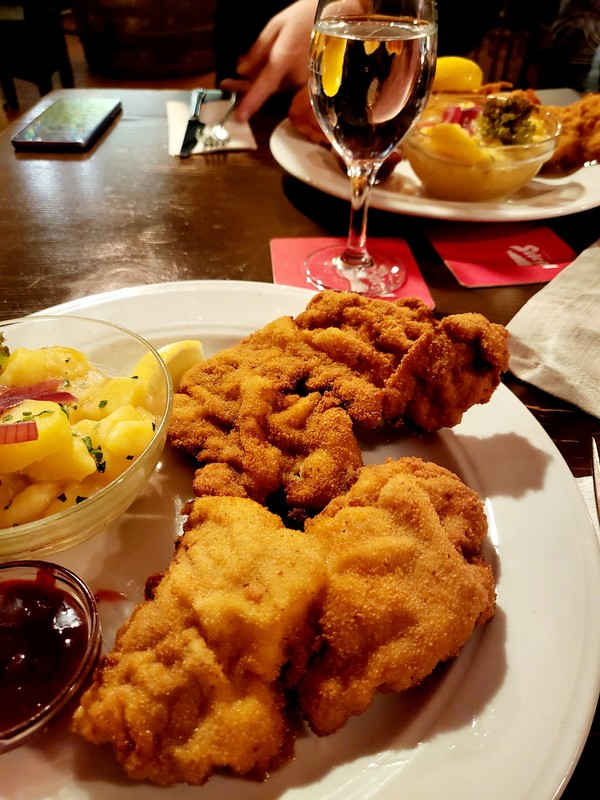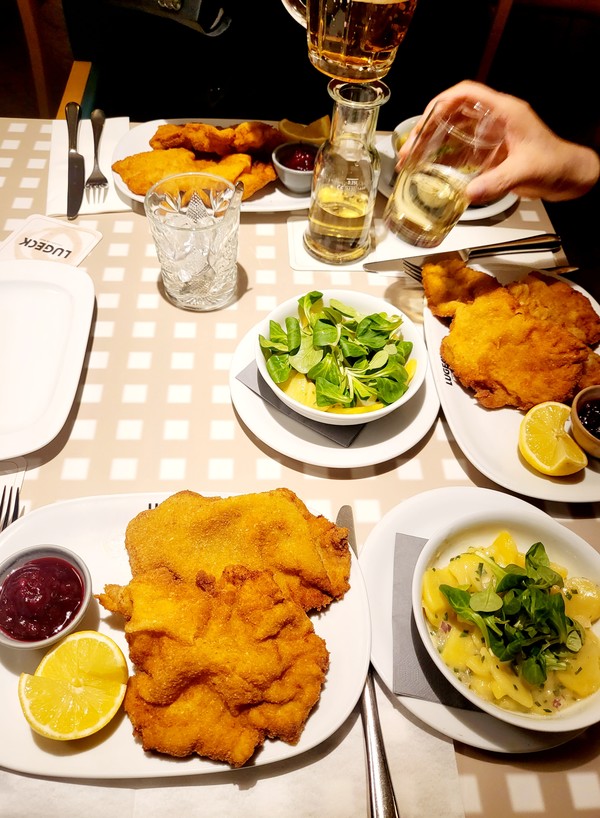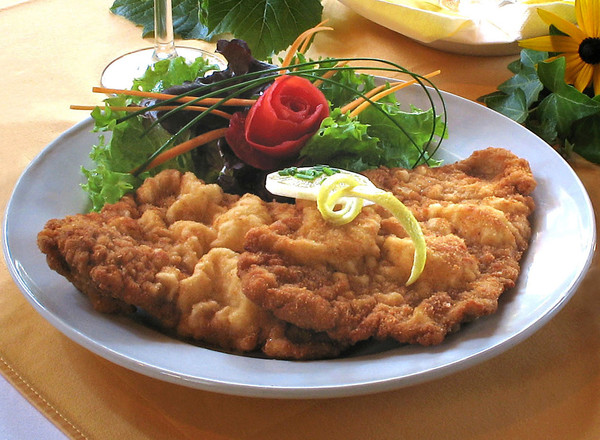The History and Cultural Significance of the 'Wiener Schnitzel'

[아츠앤컬쳐] 비너 슈니첼은 단순한 요리를 넘어 오스트리아를 대표하는 미식의 상징이다. 황금빛 바삭한 빵가루 옷과 부드러운 고기로 잘 알려진 이 상징적인 요리는 전설, 문화 교류, 요리 기술을 거쳐 수 세기와 여러 나라를 아우르는 풍부한 역사를 지니고 있다. 빵가루를 입힌 슈니첼의 기원은 12세기 콘스탄티노플에서 찾을 수 있다. 당시에는 고기를 반죽으로 감싸 튀겨 먹었다. 15~16세기에 이르면 북이탈리아, 특히 롬바르디아 지방에서 빵가루를 입혀 튀긴 송아지 커틀릿인 ‘코스톨레타 알라 밀라네제’가 시작되었다. 일설에 따르면, 라데츠키 원수가 1857년 밀라노식 커틀릿 조리법을 빈으로 가져왔고, 빈의 요리사들이 빵가루와 송아지고기를 활용해 이를 변형했다고 한다.
“비너 슈니첼”이라는 이름이 처음 문헌에 등장한 것은 1831년 빈 요리책에서다. 19세기 내내 슈니첼은 크리스마스, 새해, 결혼식 같은 특별한 날에 올려지는 축제 음식이 되었으며, 오스트리아의 도시화와 생활수준 향상과 함께 일반 대중에게까지 퍼져 ‘일요일의 요리’로 자리 잡았다. 정통 비너 슈니첼은 얇게 두드린 송아지고기에 밀가루, 달걀물, 빵가루 순으로 입힌 뒤 노릇노릇해질 때까지 튀긴다. 여기서 빵가루 옷의 질감이 매우 중요하다. 고기에 느슨하게 달라붙어 바삭하면서도 기포가 형성되어야 한다. 보통 슈니첼에는 레몬 조각을 곁들여 빵가루 위에 레몬즙을 뿌려 먹는데, 이것은 20세기 초부터 내려온 관습이다.
오늘날 비너 슈니첼은 전 세계 메뉴에서 찾아볼 수 있으며, 흔히 돼지고기를 사용한 변형 요리(“슈니첼 비너 아트”)도 많다. 하지만 원래 비너 슈니첼은 여전히 송아지고기로 만들고, 전통적인 빈의 빵가루 옷과 조리법을 통해 이 요리의 역사와 정체성을 보여준다.

비너 슈니첼은 단순한 미식의 즐거움이 아니라, 다양한 시대와 지역의 영향을 받아 발전한 빈 요리의 개방성과 창의성을 상징한다. 지중해의 세련미와 오스트리아의 편안함이 어우러진 이 요리는 오늘날 오스트리아 음식 문화의 중요한 일부이다. 고급 요리에서 일상의 고전 메뉴로 자리 잡은 비너 슈니첼은 여전히 식탁 위의 오스트리아 역사를 담고 있다.
결론적으로, 비너 슈니첼은 오스트리아의 풍부한 요리 유산을 보여주는 증거다. 그 여정은 콘스탄티노플의 부엌에서 빈의 식탁으로, 그리고 전 세계로 뻗어 나갔다. 19세기 말 메이지 시대(1868~1912) 일본은 근대화 과정에서 서양식 스타일을 적극적으로 수용했으며, 음식도 예외가 아니었다. 영국과 프랑스 요리의 빵가루 커틀릿은 일본 요리인 돈카츠의 탄생에 영향을 미쳤다. 이어 일제강점기(1910~1945)에는 일본인의 입맛에 맞게 변형된 요쇼쿠(양식요리)가 한국에 전해졌다. 해방 이후 20세기 전반에 걸쳐 이러한 음식은 한국 요리에 더욱 깊이 스며들었고, 오늘날의 돈가스로 자리 잡았다.
일본과 한국에서는 슈니첼이 주로 돼지고기로 만들어졌으며, 각 지역 특산 반찬과 곁들여졌다. 한국에서 인기 있는 요리 중 하나는 등심 돈가스다. 주된 차이점은 빵가루에 있는데, 한국은 바삭하고 굵은 입자의 판코를, 빈은 고운 빵가루를 사용한다. 두 방식 모두 맛의 매력이 뛰어나다.

The History and Cultural Significance of the 'Wiener Schnitzel'
The Wiener Schnitzel is more than just a dish; it is a culinary symbol of Austria, renowned for its golden-brown breading and tender meat. This iconic dish has a rich history that spans centuries and various countries, influenced by legends, cultural exchanges, and culinary expertise.
The origins of breaded schnitzel can be traced back to the 12th century in Constantinople, where meat was coated in dough and fried. By the 15th and 16th centuries, the famous "Costoletta alla milanese," a breaded and fried veal cutlet, was being prepared in Northern Italy, particularly in Lombardy. A popular legend suggests that Field Marshal Radetzky brought the recipe for the Milanese cutlet to Vienna in 1857, where it was adapted by Viennese chefs using breadcrumbs and veal.
The first documented mention of "Wiener Schnitzel" is from a Viennese cookbook in 1831. Throughout the 19th century, the schnitzel became a festive dish, served on special occasions like Christmas, New Year, and weddings. Its popularity spread among the general population with increasing prosperity and urbanization in Austria, making it a beloved "Sunday dish".
The authentic Wiener Schnitzel is made exclusively from thinly pounded veal, which is first coated in flour, then beaten egg, and finally breadcrumbs. The meat is then fried until golden brown. The quality of the breading is crucial; it should adhere loosely to the meat and be crispy, ideally forming air bubbles. A slice of lemon is typically served with the schnitzel to drizzle some juice over the breading, a practice documented since the early 20th century.

Today, Wiener Schnitzel can be found on menus around the world, often with variations using pork ("Schnitzel Wiener Art"). However, the original remains the veal Wiener Schnitzel, which reflects the history and tradition of this dish through its authentic Viennese breading and preparation.
The Wiener Schnitzel represents not only culinary delight but also the innovation and openness of Viennese cuisine, influenced by various epochs and regions. It symbolizes the blend of Mediterranean sophistication and Austrian comfort and is now an important part of Austria's culinary identity. From a luxury dish to a classic of everyday cuisine, the Wiener Schnitzel remains a piece of Austrian history on the plate.
In conclusion, the Wiener Schnitzel is a testament to the rich culinary heritage of Austria. Its journeys from the kitchens of Constantinople to the tables of Vienna, and eventually to the world. In in the late 19th century, during the Meiji era (1868–1912), Japan actively adopted Western styles, including food, as part of modernization efforts.
Breaded cutlets like those found in British and French cuisine influenced the creation of Japanese dishes such as tonkatsu.
Under Japanese rule (1910–1945), Western-style foods adapted to Japanese tastes (yoshoku) were introduced to Korea.
After the end of Japanese occupation and throughout the 20th century, these foods became further integrated into Korean cuisine, with dishes like Donkatsu.
In Japan and Korea, the breaded cutlet usually became pork-based and was served with local side dishes. One of the best dishes served in Korea is the Pork Loin Donkatsu. The main differences are the Breadcrumb, Korea uses Panko (coarse, crispy) and Vienna Fine breadcrumbs. Both styles are fantastic in taste.

글 | 볼프강 슬라빈스키 Wolfgang Slawinski
서울명예시민
한·오스트리아협회 회장

